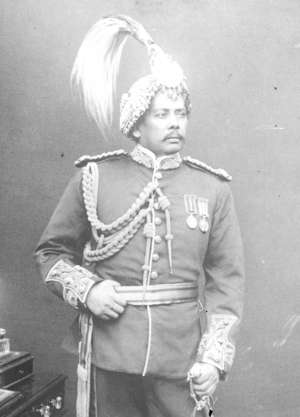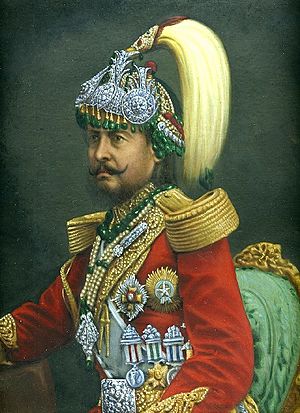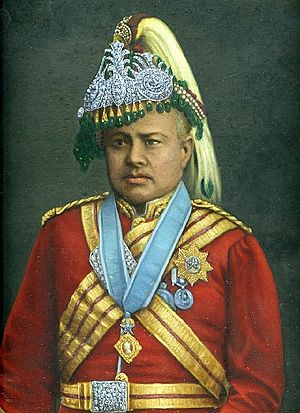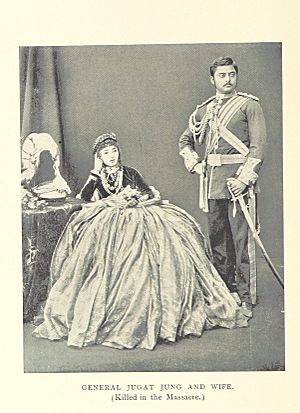Dhir Shumsher Rana facts for kids
Quick facts for kids
Commanding-General
Shree Isht Devata Charan Shree Madhara Jang Kumara Kumarangtamaya Shree Dhir Shumsher Rana
Rana
|
|
|---|---|
| धीर शम्शेर कुँवर राणा |
|

Commander-In-Chief of the Nepalese Army Dhir Shumsher Kunwar Ranaji (1828–1884)
|
|
| Commander-In-Chief of the Nepalese Army | |
| In office 11 May 1879 – 14 October 1884 |
|
| Monarch | Surendra of Nepal Prithvi Bir Bikram Shah |
| Preceded by | Jagat Shumsher Rana |
| Succeeded by | Jit Jung Rana |
| Personal details | |
| Born | c. 1828 |
| Died | 14 October 1884 Kathmandu, Kingdom of Nepal |
| Spouses | Nanda Kumari Thapa (third wife) Juhar Kumari Devi (fifth wife) |
| Children | see below |
| Parents |
|
| Relatives | see Kunwar family; see Rana dynasty; see Thapa dynasty; see Pande dynasty |
| Military service | |
| Allegiance | |
| Battles/wars | Nepalese-Tibetan War, Indian Mutiny of 1857 |
Dhir Shumsher Kunwar (1828 – 1884 Kathmandu), also known as Dhir Shumsher Rana, was an important Nepalese politician and army general. He served as the Commander-In-Chief of the Nepalese Army from 1879 to 1884.
He was born into the Kunwar family as the youngest son of Kaji Bal Narsingh Kunwar. His mother was Ganesh Kumari Thapa. Dhir Shumsher was the youngest brother of Jang Bahadur Kunwar Ranaji. Jang Bahadur later became the Prime Minister of Nepal. Dhir Shumsher played a role in the Kot Massacre, an event where many powerful people were killed. He protected his brother, Krishna Bahadur Kunwar Rana, during this time. After this event, Dhir became a military Colonel. He also traveled to Europe with Jung Bahadur in the early 1850s.
Dhir Shumsher led the Nepalese Army in two successful wars. These were the Nepalese-Tibetan War (1855–1856) and the Indian Mutiny of 1857. He gained more power when his older brother, Jagat Shamsher Kunwar Rana, died in 1879. After this, Dhir became the Commander-In-Chief of the Nepalese Army. He was a strong supporter of his brother, Shri Tin Maharaja Ranodip Singh Bahadur Kunwar Rana, who was the Prime Minister. Dhir protected his brother's position from a coup attempt in 1881–82. This event was known as "38 Saalko Parva." His presence helped prevent a big conflict between his 17 sons and Jung Bahadur's sons. Dhir's death in 1884 opened the way for his 17 sons, known as the Shamsher Ranas, to take control of power.
Contents
Early Life and Family
- Further information: Kunwar family
- Further information: Rana dynasty
Dhir Shumsher was born around 1828. He was the youngest son of Kaji Bal Narsingh Kunwar and Ganesh Kumari Thapa. His brothers from Ganesh Kumari included Jang Bahadur, Bam Bahadur, Badri Narsingh, Krishna Bahadur, Ranodip Singh, and Jagat Shamsher. He was known as "Sannani" in his family.
Important Events in His Life
Kot Massacre and Europe Visit

Jung Bahadur Kunwar and his brothers took control of important government positions after the Kot Massacre. Dhir Shumsher played a key role in this event. He stopped an attack on his brother, Krishna Bahadur Kunwar Rana. The day after the massacre, he was promoted to the military rank of colonel.
In 1851, Dhir Shumsher traveled to Europe with his eldest brother, Prime Minister Jang Bahadur Rana. During their trip to England, Dhir even defeated an English wrestling champion. In Paris, he had a minor injury when a young girl accidentally shot Jang Bahadur's pistol, hitting Dhir.
By 1853, General Dhir Shumsher was the sixth most powerful person in the Government of Nepal. He earned a yearly salary of NPR 21,853.00.
1855–56 Tibetan War
The Government of Nepal declared war on Tibet. This was because Nepalese traders and representatives in Lhasa were not treated well. General Dhir Shumsher led the Nepalese Army at the Kuti front. He had 4678 soldiers under his command.
On April 3, 1855, General Dhir Shumsher defeated a small Tibetan force at Chusan. He captured the Kuti front and moved further to Suna Gompa. He set up a supply base in Duguna village, near Listi in Nepal. He then led an attack on the Sona Gompa fortress, which had 8000 Tibetan soldiers. The battle was very difficult for both sides, but the Tibetans eventually retreated.
In November 1855, Tibetan forces launched surprise attacks on Nepalese camps at Kuti and Dzongka. The Nepalese forces at Kuti suffered heavy losses and had to retreat. However, in December 1855, Dhir Shumsher recaptured Kuti. He received extra soldiers from Jung Bahadur. Before returning to Nepal, he burned the town of Kuti.
Indian Mutiny
- Further information: Indian Rebellion of 1857
Jang Bahadur ordered Dhir Shumsher to lead 3000 Nepalese soldiers. Their mission was to help the British put down the Indian Mutiny of 1857. The Gorkhali forces helped the British regain control in places like Lucknow and Gorakhpur. They also succeeded in Bihar, Azampur, Jaunpur, Allahabad, and Oudh. However, Dhir Shumsher did not agree with supporting the British. He had a policy against them.
Later Years and Challenges
According to a list of succession made in 1868, Dhir was fourth in line to become Prime Minister. He was also the Commanding-General of the Eastern Command of the Nepal Army. In 1871, Dhir Shumsher received land in the eastern hills. This land was meant for growing tea.
Family Conflicts and Coup Attempts
Jang Bahadur died in March 1877. Dhir Shumsher spread a rumor that Jang Bahadur was very sick. This made Crown Prince Trailokya of Nepal and Jang Bahadur's sons rush to Patharghatta. While they were away from Kathmandu, Dhir convinced King Surendra of Nepal to declare Ranodip Singh Kunwar as the new Prime Minister of Nepal. This move stopped a plan by Jagat Jang, Jang Bahadur's eldest son, and Crown Prince Trailokya. They had wanted King Surendra to step down and appoint Jagat Jang as Prime Minister.
When Commander-in-Chief Jagat Shamsher Kunwar Rana died in 1879, Dhir Shumsher took his place. Dhir Shumsher did not want to give his position to Jagat Jang. This made the relationship between Dhir Shumsher and his nephew Jagat Jang worse.
In 1881–1882, a group of people tried twice to overthrow both Prime Minister Ranodip Singh Kunwar and Commander-in-Chief Dhir Shumsher Rana. Both attempts failed. For the third attempt, the date was set for December 14, 1881. Prime Minister Ranodip Singh went on a hunting trip. The plotters tried to get help from Lieutenant Uttardhwaj. However, Uttardhwaj told Dhir Shumsher about the plan. Dhir Shumsher immediately told his brother, Ranodip Singh, to arrest the plotters with him. Dhir Shumsher also arrested plotters in Kathmandu. Many people involved in the plot were punished.
Administration

Historians believe that Dhir Shumsher was the main support for Prime Minister Ranodip Singh Kunwar's government. One historian called him the Chief Executive of Nepal. Until his death in 1884, Dhir Shumsher held the real power. This was because Ranodip Singh was often ill and a less strong ruler. Ranodip Singh always listened to Dhir Shumsher. Dhir also did not allow the British to recruit Gorkhali soldiers from Nepal, even though Ranodip Singh was in favor of it. After Dhir's death, Ranodip Singh allowed Gorkhali recruitment in the British Army.
As a Commanding General, Dhir Shumsher helped manage land taxes. He ordered a reduction of land taxes in Dang in 1879. He also directed the collection of land taxes from unused lands in the region in 1881. He also restarted mail services in Chitwan in October 1882.
Allowances
As the Commander-in-Chief of the Nepalese Army, Dhir Shumsher received an annual allowance of NRs 16,000.
Family and Personal Life
Dhir Shumsher had five wives. One of his wives was Nanda Kumari Thapa. Another was Juhar Kumari Devi, from a noble Rajput family in Kangra.
Sons
Dhir Shumsher had 17 sons and 17 daughters. His seventeen sons were known as the Shamsher faction or Satra Bhai (meaning 'seventeen brothers'). They started adding "Jang Bahadur Rana" to their names. They became very powerful. Five of them became Commander-in-chief of the Nepalese Army and Prime Minister of Nepal between 1885 and 1945.
The list of Dhir Shumsher's seventeen sons includes:
- Bir Shamsher Jang Bahadur Rana (who became Prime Minister)
- Khadga Shamsher Jang Bahadur Rana (who became Commander-in-chief)
- Rana Shumsher Jung Bahadur Rana (who became Commander-in-chief)
- Dev Shamsher Jang Bahadur Rana (who became Prime Minister)
- Chandra Shamsher Jang Bahadur Rana (who became Prime Minister)
- Bhim Shamsher Jung Bahadur Rana (who became Prime Minister)
- Fatte Shamsher Jung Bahadur Rana
- Lalit Shamsher Jung Bahadur Rana
- Jit Shamsher Jung Bahadur Rana
- Juddha Shamsher Jung Bahadur Rana (who became Prime Minister)
- Dambar Shamsher Jung Bahadur Rana
- Jadu Shamsher Jung Bahadur Rana
- Purna Shamsher Jung Bahadur Rana
- Durga Shamsher Jung Bahadur Rana
- Shere Shamsher Jung Bahadur Rana
- Khamba Shamsher Jung Bahadur Rana
- Harka Shamsher Jung Bahadur Rana
Daughters
One of Dhir Shumsher's daughters, Princess Khadga Divyeshwari Devi, married Lakshmi Narayan Shah of Salyan. She received a house from King Prithvi Bir Bikram Shah Dev in 1909.
Personality
Historian Ishwari Prasad said that Dhir Shumsher "had the qualities of a soldier and a statesman." He also understood Nepal's situation very well. Writer Madhvi Yashin described Dhir as "a man of blood and iron." Another writer, Charles Allen, called Dhir "both a hard-bitten warrior and a statesman." He also noted that Dhir "effectively ruled Nepal in his brother’s name."
Memorials
A statue of Dhir Shumsher on a horse was built in the middle of Tundikhel.
Death and What Happened Next
Dhir Shumsher died on October 14, 1884. His death allowed his sons to gain power over their cousins. In 1885, the Shamsher brothers carried out a coup. During this event, Prime Minister Ranodip Singh Kunwar was killed. This coup established the "rule of seventeen brothers" and started a new era in Nepal's history.
Gallery




